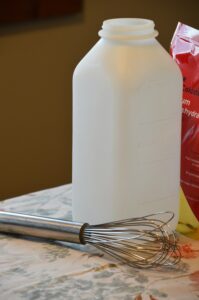The Key to Setting up a Healthy Calf for Life? Colostrum
The following is part two of a series of three posts featuring calving management practices and intervention strategies to help producers optimize newborn calf health and well-being. Read part one to learn about resuscitation techniques and part three to learn about when and how to use electrolytes.
Newborn calves are born with virtually no immunity of their own. Unlike other mammals, a cow’s placenta does not allow antibodies to pass from the mother to the calf during pregnancy, which means the calf must receive its initial immunity from the antibody-rich colostrum, or first milk, of the cow. This initial immunity is essential because it provides protective antibodies against many of the diseases that affect newborn calves, such as calf scours, navel abscesses, arthritis and pneumonia. If the calf is at risk of not having adequate colostrum, such as if it had a difficult birth, is a twin, is delivered via c-section, has a weak suckle reflex, or hasn’t sucked in the first few hours of life, supplementation is recommended. If a calf requires colostrum supplementation, here are a few things to consider.
- The ideal intake is two litres of colostrum within the first two hours of life and another two litres in the next eight to twelve hours.
- Colostrum from the calf’s mother is the preferred source. Safely restrain the cow and milk her colostrum into a disinfected bottle or feeding tube. If that is not an option, choose from stored colostrum from other cattle on your farm, or a freeze-dried, powdered commercial colostrum product.
- Start a colostrum bank from mature cows within your own herd that have with plentiful colostrum (or from cows that lose calves at birth).

- At the start of calving season, make sure you have a powdered colostrum product on hand that has at least 100 grams of immunoglobulin G (IgG) per package and reconstitutes to the smallest volume possible. Read the product label carefully to see if the package is a “replacement” or a “supplement” as supplements contain fewer grams of IgG.
- If it is not being used within the hour, cow colostrum should be frozen. It can remain in the freezer for up to a year.
- Make sure to clean and disinfect bottles or tubes after feeding. Have separate marked bottles for colostrum for newborns versus electrolytes or medicines for sick calves.
- Thaw frozen colostrum slowly. If it heats up too fast it will destroy the proteins. Set frozen colostrum in hot (but not boiling) water. Do not use the microwave to thaw colostrum as it breaks down the protein.
Ensuring a calf has adequate colostrum at birth is one of the most important ways a producer can set that calf up for a successful and productive life. For more information visit our Calving and Calf Management webpage.
Click here to subscribe to the BCRC Blog and receive email notifications when new content is posted.
The sharing or reprinting of BCRC Blog articles is welcome and encouraged. Please provide acknowledgement to the Beef Cattle Research Council, list the website address, www.BeefResearch.ca, and let us know you chose to share the article by emailing us at [email protected].
We welcome your questions, comments and suggestions. Contact us directly or generate public discussion by posting your thoughts below.